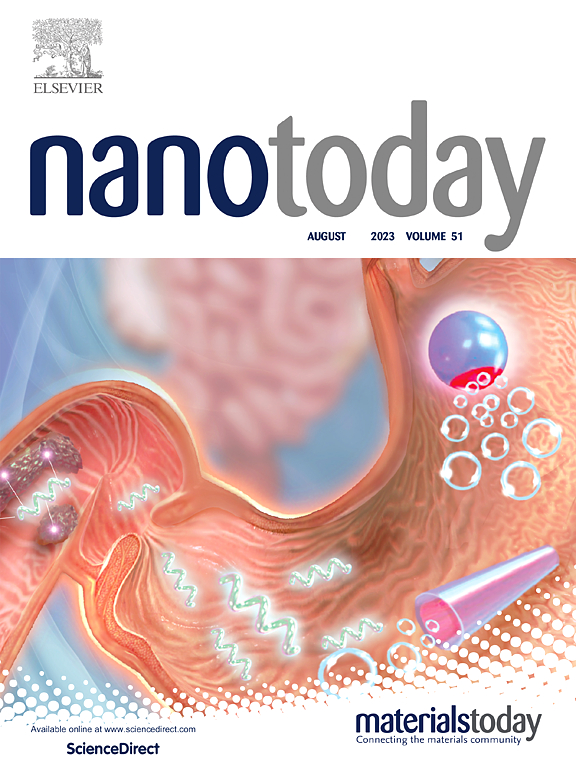Disruption of intracellular calcium homeostasis drives graphene quantum dots-induced inflammatory response in liver macrophages
IF 13.2
1区 材料科学
Q1 CHEMISTRY, MULTIDISCIPLINARY
引用次数: 0
Abstract
Graphene quantum dots (GQDs), with photoluminescent properties, high stability, and excellent biocompatibility, hold tremendous potential in biomedicine. It is urgent to evaluate their safety and potential health risks to promote their clinical application. Kupffer cells (KCs), as primary immune cells encountered by foreign substances entering the liver and integral to liver immunity, have yet to be systematically studied for toxicity responses to different GQDs. This study focused on three widely used GQDs (OH-GQDs, N-GQDs, and NH2-GQDs), examining their effects on KCs and elucidating the underlying mechanisms. Our findings suggested that the toxicity levels of the three GQDs on KCs are ranked as OH-GQDs > N-GQDs > NH2-GQDs, with inflammation being the main form of toxic effect, which was a consequence of GQD-induced calcium homeostasis disruption. Specifically, cytoplasmic calcium imbalance caused by GQDs leaded to mitochondrial Ca2 + overload, mitochondrial dysfunction, and mtROS generation, which subsequently activated the NLRP3 inflammasome-dependent inflammation. Crucially, we identified upstream mechanistic differences in calcium homeostasis disruption induced by each GQDs, with the most toxic OH-GQDs inducing ER stress-mediated Ca2+ release, which was closely related to the depletion of GSH caused by the generation of oxygen free radicals (•OH and O2•−). By tracing Ca2+ homeostasis, this work comprehensively mapped the upstream and downstream mechanisms of GQD-induced liver macrophage inflammation, providing new insights into the toxic effects of GQDs. Additionally, linking the intrinsic properties of GQDs, we identified the molecular initiating events of OH-GQDs mediated excessive inflammation in KCs, offering strategies for the de novo safe design of GQDs that target the content of oxygen-containing functional groups and the generation capacity of free radicals, which is of great significance for the development of safe, non-toxic, and efficient GQDs for clinical diagnosis and treatment.
破坏细胞内钙稳态驱动石墨烯量子点诱导的肝巨噬细胞炎症反应
石墨烯量子点具有光致发光特性、高稳定性和良好的生物相容性,在生物医学领域具有巨大的应用潜力。评价其安全性和潜在的健康风险,促进其临床应用是当务之急。库普弗细胞(KCs)作为进入肝脏的外来物质所遇到的原代免疫细胞,是肝脏免疫系统的组成部分,目前尚未对不同GQDs的毒性反应进行系统研究。本研究主要针对三种广泛使用的GQDs (OH-GQDs、N-GQDs和NH2-GQDs),研究它们对KCs的影响并阐明其潜在机制。我们的研究结果表明,三种GQDs对KCs的毒性水平排名为OH-GQDs >; N-GQDs >; NH2-GQDs,炎症是毒性作用的主要形式,这是gqd诱导钙稳态破坏的结果。具体来说,GQDs引起的细胞质钙失衡导致线粒体Ca2 +超载、线粒体功能障碍和mtROS的产生,随后激活NLRP3炎性小体依赖性炎症。至关重要的是,我们确定了每种GQDs诱导的钙稳态破坏的上游机制差异,其中毒性最大的OH-GQDs诱导内质网应激介导的Ca2+释放,这与氧自由基(•OH和O2•−)产生引起的GSH消耗密切相关。通过追踪Ca2+稳态,本工作全面绘制了gqd诱导的肝巨噬细胞炎症的上下游机制,为gqd的毒性作用提供了新的见解。此外,结合GQDs的内在特性,我们确定了OH-GQDs介导KCs过度炎症的分子启动事件,为针对含氧官能团含量和自由基生成能力的GQDs从头安全设计提供了策略,这对于开发安全、无毒、高效的GQDs用于临床诊断和治疗具有重要意义。
本文章由计算机程序翻译,如有差异,请以英文原文为准。
求助全文
约1分钟内获得全文
求助全文
来源期刊

Nano Today
工程技术-材料科学:综合
CiteScore
21.50
自引率
3.40%
发文量
305
审稿时长
40 days
期刊介绍:
Nano Today is a journal dedicated to publishing influential and innovative work in the field of nanoscience and technology. It covers a wide range of subject areas including biomaterials, materials chemistry, materials science, chemistry, bioengineering, biochemistry, genetics and molecular biology, engineering, and nanotechnology. The journal considers articles that inform readers about the latest research, breakthroughs, and topical issues in these fields. It provides comprehensive coverage through a mixture of peer-reviewed articles, research news, and information on key developments. Nano Today is abstracted and indexed in Science Citation Index, Ei Compendex, Embase, Scopus, and INSPEC.
 求助内容:
求助内容: 应助结果提醒方式:
应助结果提醒方式:


